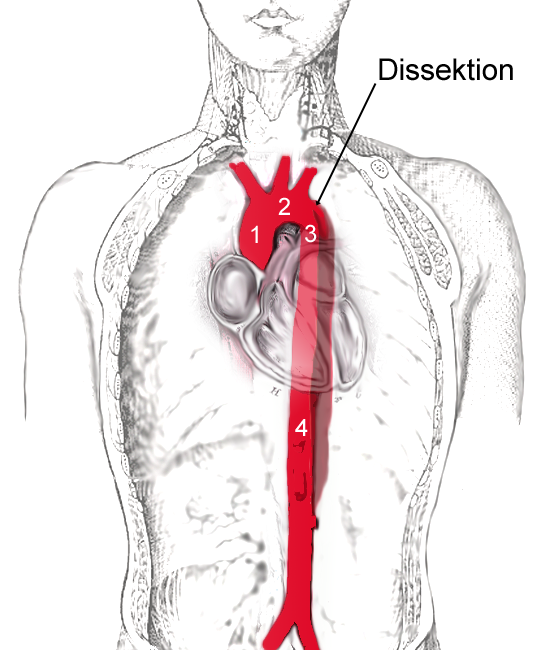Aortic Conditions - Aortic Dissection Explained
Good day to you from any part of the world, you are reading this. I would have used a specific time which could be morning, afternoon, or night but we all live in different timezones so we all would be reading this post at different hours and times of the day. Previously, I discussed Abdominal Aortic Aneurysm (AAA) but then, I realize that it will be good to pick it from the very beginning and explain aortic aneurysms, so today, I will be looking at aortic dissection and Aneurysms. A quick one, an aorta aneurysm is an abnormal dilation of the aorta which can be true, aneurysms, where the three layers of the wall are dilated, while with false aneurysms, where the extravascular wall is seperated from in the intravascular wall.
So, we know that our heart is responsible for pumping blood to our body and this is done through blood vessels, with the arteries taking blood away from the heart to the capillaries which supply the tissues, which then return the blood to the capillaries then to the veins which take the blood back to the heart. This is a simple way of explaining blood circulation from the heart and back to the heart but from the heart, there is a large vessel known as the aorta which carries the blood the heart pumps to the arteries today, I will be discussing a condition that affects the aorta.
The Aorta which comes from the heart goes upwards to form the arch of the aorta known as the aortic arch, then it goes down behind the heart becoming the thoracic aorta, at the thoracic region, then down at the abdomen, it becomes the abdominal aorta, then below it splits to become the Iliac artery. The aorta also split to give the renal artery which supplies the kidney, the brachio-cephalic artery, the coronary artery, and so on. It is the vessel that takes blood to every other part of the body. Aortic Dissection is a condition where there is a separation in the layers of the aorta wall. This is a life-threatening condition and it should be attended to as an emergency. The aorta walls have three layers or tunics with the outermost tunic being the tunica adventitia, the middle layer which is a thick muscular layer or the aorta wall being the tunica media, and the inner part of the aorta is the intima tunica, which is a thin layer wall. Where the blood flows through the aorta is known as the lumen. The aortic wall experiences high pressure and stress as a result of the way the heart pumps, and this can cause injury to the aorta. With Aortic dissection, there is often a tear in the intima, causing blood to go into the media layer leading to the tearing away of the intima from the media. The tear can continue leading to expansion and swelling leaving the circulation and going to the dissection creating a false lumen which is between the intima and the media.
This condition can become severe leading to shock or hypertension but actually, the most common cause of this condition is hypertension, then connective disorders such as Marfan's syndrome, Ehlers-Danlos Syndrome, Chest trauma, and an increase in age. Aortic dissection can be classified by two systems which are Standford's system and the Debakey system. The Standford system can be divided into types A and B. Type A aortic dissection refers to the dissection of any part of the aorta before the left subclavian artery origin. Basically, it starts around the beginning of the aorta towards the aorta arch but before the left subclavian artery. As you guessed right, type B aortic dissection occurs after the left subclavian artery and it could go downwards. With type A dissection, it is usually common around the aortic valve, and around the aortic root, while type B dissection occurs after the left subclavian artery. The DeBakey classification divides the type of Aortic dissection into 3 types, Type 1, Type 2, and Type 3. Type 1 aortic dissection originates in the ascending aorta but not exceeding the aortic arch. Type 2 originates and is limited to the ascending aorta, while Type 3 starts at the descending Aorta above the diaphragm.
People who have this condition feel a sudden onset of severe chest pain which radiates to the back, then to the arm. The patient could experience sweating, shortness of breath, fainting, nausea, weakness, and abdominal pain if it occurs in the abdominal region. Diagnosis can be done with a transesophageal Echocardiogram (TEE), Computerized tomography (CT), and a Magnetic Resonance Angiogram (MRA). Type A aortic dissection can be treated using medications but Type B aortic arch requires immediate surgery.
https://www.ncbi.nlm.nih.gov/books/NBK441963/
https://www.ahajournals.org/doi/full/10.1161/CIRCULATIONAHA.108.799908

Thanks for your contribution to the STEMsocial community. Feel free to join us on discord to get to know the rest of us!
Please consider delegating to the @stemsocial account (85% of the curation rewards are returned).
Thanks for including @stemsocial as a beneficiary, which gives you stronger support.